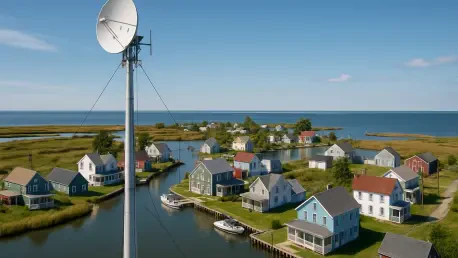In a groundbreaking stride toward digital equity, Governor Wes Moore has heralded the completion of a nearly $2 million broadband infrastructure project on Smith Island, Maryland, a remote gem in the Chesapeake Bay. As the state’s last inhabited island not accessible by car, Smith Island has long grappled with isolation that hindered connectivity for its residents, making this initiative a vital step forward. This ambitious project, touching over 200 households and businesses in Somerset County, stands as a beacon of progress in bridging the digital divide for one of Maryland’s most secluded communities. Governor Moore’s visit to the island—the first by a sitting governor since 1999—demonstrates a profound commitment to ensuring that every Marylander, regardless of location, steps into the digital era. The project not only addresses a critical need but also symbolizes a promise to transform lives through technology, sparking curiosity about how such advancements can reshape remote areas.
Transforming a Remote Community
Breaking Barriers with Connectivity
The collaborative effort between the state of Maryland, the Maryland Department of Housing and Community Development’s Office of Statewide Broadband, and Verizon has yielded transformative results for Smith Island. With high-speed internet now accessible, residents and businesses can tap into essential digital services such as telehealth, online education, and seamless communication tools. For a community long challenged by its geographic separation from the mainland, this connectivity serves as a vital link to the modern world. Local entrepreneurs, particularly in tourism and hospitality, are already envisioning growth through enhanced online marketing and streamlined booking systems. This development marks a significant shift, turning what was once a barrier into an opportunity for economic and social advancement, allowing the island to integrate more fully into the broader digital landscape.
Community Voices Celebrate Change
Feedback from Smith Island’s community leaders paints a vivid picture of the project’s impact on daily life and future prospects. Eddie Somers, president of Smith Island United, described the installation of a 5G network as nothing short of a “game changer” for both residents and local businesses. Similarly, Somerset County Commission Vice President Randy Laird emphasized the far-reaching benefits, noting improvements in access to healthcare, educational resources, and even cultural preservation. These local perspectives highlight how internet access can redefine quality of life, from enabling students to participate in virtual learning platforms to empowering small businesses with better outreach to customers. The enthusiasm among stakeholders reflects a shared recognition of technology as a catalyst for sustaining and enriching the island’s unique way of life in an increasingly connected world.
Statewide Commitment to Digital Equity
Building a Connected Maryland
Maryland’s overarching ambition to achieve universal high-speed internet access by 2030 provides the foundation for initiatives like the one on Smith Island. Under Governor Moore’s administration, the state has already connected over 43,000 households, benefiting more than 113,000 Marylanders through substantial investments in infrastructure and digital equity programs. The Smith Island project, supported by a $1.9 million grant awarded to Verizon via the Network Infrastructure Program, showcases how targeted efforts can effectively tackle connectivity challenges in even the most isolated regions. This milestone is a testament to a broader strategy that prioritizes reaching unserved and underserved areas, ensuring that digital access becomes a reality for all corners of the state. Such progress underscores the importance of strategic funding in overcoming longstanding barriers to technology access.
Innovating for Remote Challenges
Beyond traditional internet access, the project on Smith Island has opened doors to innovative technological solutions tailored to remote environments. During Governor Moore’s visit, a demonstration by the University of Maryland Uncrewed Aircraft Systems Research and Operations Center revealed the potential of drones to deliver medical supplies across the island’s three distinct communities. Enabled by enhanced connectivity, this application of cutting-edge technology addresses critical logistical hurdles in isolated areas, particularly in healthcare delivery. The ability to transport essential items swiftly and efficiently could revolutionize emergency responses and routine medical care for residents. This forward-thinking approach illustrates how broadband infrastructure can serve as a platform for pioneering solutions, paving the way for other remote regions to adopt similar advancements in addressing their unique needs.
Looking Ahead to a Digital Future
Pioneering Partnerships and Progress
Reflecting on the strides made, the completion of the broadband project on Smith Island marked a historic moment in Maryland’s journey toward digital inclusion. The partnership between state entities and Verizon set a powerful precedent for public-private collaboration, proving that collective efforts can dismantle even the toughest connectivity barriers. Governor Moore’s hands-on engagement during the visit reinforced a dedication to understanding and uplifting remote communities. Looking forward, the state’s continued investment in infrastructure and digital equity grants offers a roadmap for other isolated areas to follow suit. Stakeholders are encouraged to build on this momentum, exploring innovative applications of technology to further enhance services like education and healthcare, ensuring that the digital divide continues to narrow across Maryland.
Sustaining Momentum for Equity
As the echoes of this achievement linger, the focus shifts to sustaining and expanding such transformative efforts. The Smith Island initiative, completed with resounding community support, highlights the need for ongoing collaboration among government, industry, and local leaders to maintain progress. Future steps should include monitoring the long-term impact of connectivity on economic growth and social well-being, while also identifying other underserved regions for similar projects. Maryland’s commitment to universal access by 2030 remains a guiding light, urging policymakers to prioritize scalable solutions and equitable resource distribution. By fostering an environment where technology serves as an equalizer, the state can ensure that every community, no matter how remote, thrives in the digital age, setting a national example for inclusive progress.









